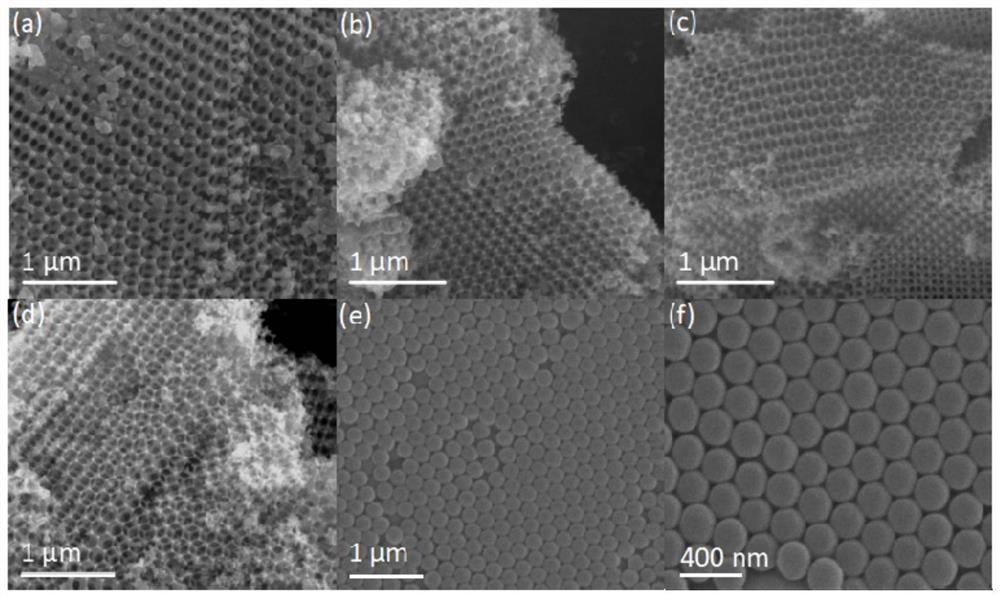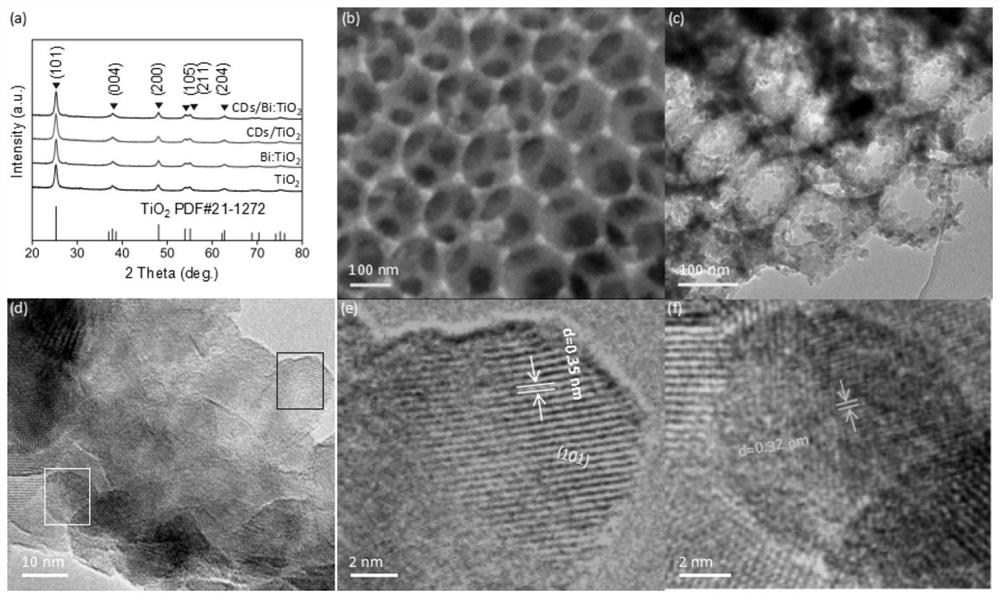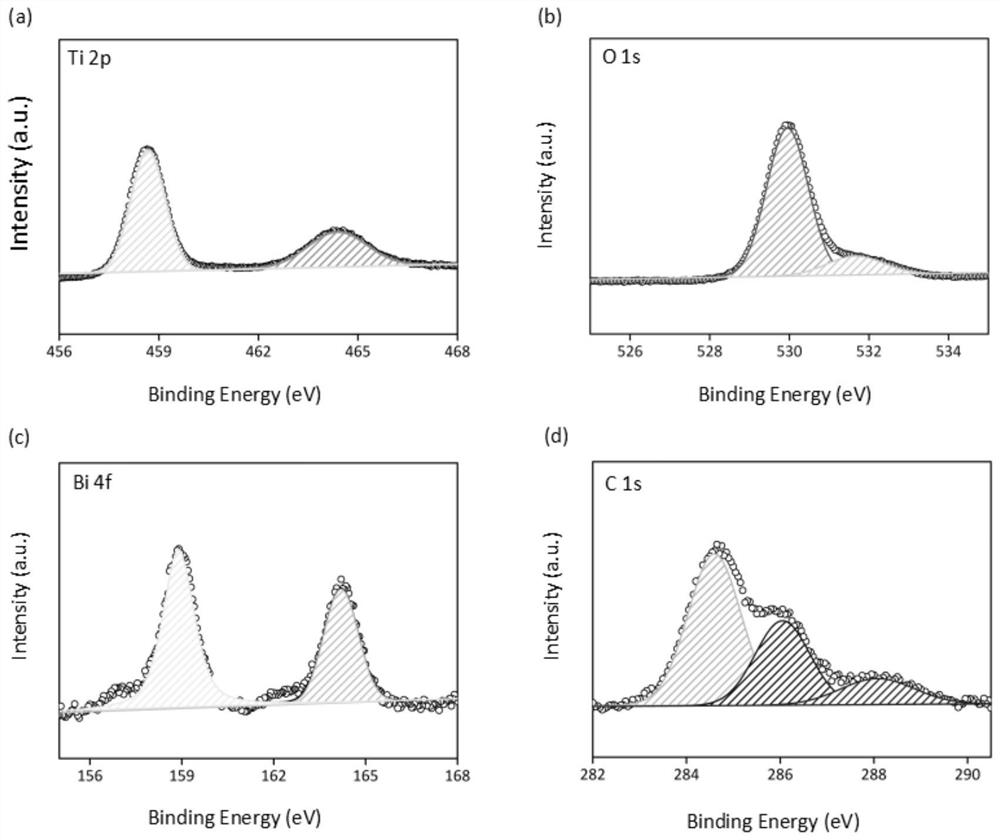A kind of photocatalyst nano material and preparation method thereof
A technology of nanomaterials and photocatalysts, which is applied in the direction of catalyst activation/preparation, chemical instruments and methods, physical/chemical process catalysts, etc., and can solve the problems of wide utilization of visible light photogenerated carriers and efficiency improvement
- Summary
- Abstract
- Description
- Claims
- Application Information
AI Technical Summary
Problems solved by technology
Method used
Image
Examples
Embodiment 1
[0049] As a method for preparing a nanomaterial in an embodiment of the present invention, the method includes the following steps:
[0050] (1) Polystyrene microspheres with an average particle size of 200 nm were synthesized by emulsion polymerization, and dried at 50°C for 24 hours to self-assemble monodisperse polystyrene microspheres (PS spheres) into polystyrene crystal templates (PS crystal template);
[0051] (2) Preparation of 3DOM Bi:TiO 2 Precursor solution: mix n-butyl titanate (10mL), ethylene glycol (40mL) and nitric acid (1mL) uniformly to obtain TiO 2 Precursor liquid; a certain amount of Bi(NO 3 ) 3 ·6H 2 O (Bi / Ti molar ratio is 0.5%), ethylene glycol (6mL) and dilute nitric acid (volume fraction 30-50%, 9mL) are mixed evenly to obtain a Bi precursor solution, and the Bi precursor solution is added to the precursor solution TiO 2 In the precursor solution, stir at room temperature for 3h, and age the mixed solution at 40°C for 5h to prepare 3DOM Bi:TiO 2...
experiment example 1
[0066] The morphology of the prepared PS spheres was observed with a field emission scanning electron microscope, and the results were as follows: figure 1 As shown in (e-f), the polystyrene microspheres have an average particle size of 200 nm and are neatly arranged.
[0067] 3DOM TiO 2 、3DOM Bi:TiO 2 、3DOM 6CDs / TiO 2 、3DOM 6CDs / Bi:TiO 2 The morphology of the composite photocatalyst was observed using a field emission scanning electron microscope, and the results were as follows: figure 1 As shown in (a-d), scanning electron microscope results show that both 3DOM Bi:TiO 2 The catalyst is still 3DOM 6CDs / Bi:TiO 2 The catalysts all maintain a clear and continuous three-dimensional macroporous structure.
[0068] X-ray powder diffraction test was carried out on it, and the results are as follows: figure 2 As shown, both 3DOM Bi:TiO 2 Or 3DOM6CDs / Bi:TiO 2 , X-ray powder diffraction patterns all show that anatase TiO with very high crystallinity is maintained 2 Due to t...
Embodiment 2
[0071] As a method for preparing nanomaterials in the embodiment of the present invention, the only difference between this embodiment and embodiment 1 is that the molar ratio of Bi to Ti is in the range of 0.25-1.5%, respectively 0.25%, 0.5%, and 1%. , 1.5%. The synthesized sample was named 3DOM 6CDs / Bi (n) :TiO 2 , where n represents the molar ratio of Bi / Ti.
[0072] The photocatalytic performance of the nanometer material of present embodiment, its ratio and its appearance, the relation of performance are as table 1 and Figure 7 , Figure 8 shown.
[0073] Table 1. 3DOM 6CDs / Bi with different Bi / Ti molar ratios (n) :TiO 2 preparation of
[0074]
PUM
| Property | Measurement | Unit |
|---|---|---|
| particle size | aaaaa | aaaaa |
| particle size | aaaaa | aaaaa |
Abstract
Description
Claims
Application Information
 Login to View More
Login to View More - R&D
- Intellectual Property
- Life Sciences
- Materials
- Tech Scout
- Unparalleled Data Quality
- Higher Quality Content
- 60% Fewer Hallucinations
Browse by: Latest US Patents, China's latest patents, Technical Efficacy Thesaurus, Application Domain, Technology Topic, Popular Technical Reports.
© 2025 PatSnap. All rights reserved.Legal|Privacy policy|Modern Slavery Act Transparency Statement|Sitemap|About US| Contact US: help@patsnap.com



